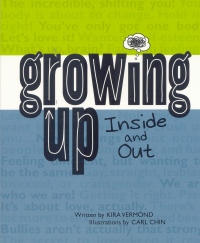| ________________
CM . . .
. Volume XX Number 15. . . .December 13, 2013
excerpt:
Years ago (i.e. the last century, when I was a teenager), books about “growing up” were gender-specific. Girls learned about menstruation and pregnancy, and boys learned about . . . actually, I’m not sure what their books on puberty taught them. Perhaps how to shave and use deodorant. Growing Up: Inside and Out certainly provides all the necessary info on what happens when hormones hit those tween bodies, and the voices start to crack or the breasts start to bud. But, this is the twenty-first century, and so, the book focuses on the body change issues that concern both boys and girls: hair growth in new locations, acne, body image (and the eating disorders that may ensue as a result), and worries about the relative size of body parts, to name but a few. Adolescents spend an incredible amount of time obsessing about their looks; the author, Kira Vermond, reminds readers that “worrying about how you look is really common. Nearly everybody feels anxious from time to time . . . But that doesn’t have to be the only way to feel.” (p. 29) As any parent or teacher knows, physical growth spurts are the most obvious of the changes that make a lovable and charming nine-year-old into a sometimes unbearable teenager. It’s the mood swings, the unexpected crying jags, the uncharacteristic surliness, or the crazy mad crush on some pop singer (or cute teacher, or . . . whomever) which makes life a challenge for both the developing teen and the adults who have to live with them. Vermond’s focus on puberty’s emotional changes is what make this book so different from many others of its type, explaining the reasons why pubescent brain growth turns kids into dangerous thrill-seekers, or disorganized slobs: “human pre-teens and teens find it particularly challenging to, say, plan homework schedules and suppress the urge to play video games for three hours because the brain’s prefrontal cortex (where you make decisions and organize your thoughts) is still developing.” (p. 39) Adolescence is a time when friends seem to be more important than family. It’s tough to negotiate “feeling different, but wanting to be the same” (p. 54), and the power of peer pressure can be overwhelming. Equally difficult is the horrible feeling of exclusion and isolation that comes from being bullied. Vermond explores the push-pull of friends, enemies, frenemies and cliques. Adolescence is also a time when all those hormones which change the body also agitate new feelings; some of those feelings are sexual, and they may be directed towards members of the opposite sex, or . . . the same sex. Figuring out who you are attracted to, and feeling secure in your sexual identity is a major developmental step, and this book acknowledges that “sexual orientation – the term that we use to describe a pattern of who we’re most often attracted – isn’t always a straight line or a quick process. In the end, only time will tell whom you’ll eventually love.” (p. 73) Love takes considerable maturity, and most teens aren’t really ready for it, but the chapter on “Relationships” explores what makes for a healthy relationship, whether it’s a romantic one or a friendship. The book’s final chapter not only outlines the biology of sex, it also discusses the un-reality of sex as typically depicted in pornography, the dangers of “sexting”, the importance of protection against unwanted pregnancy and STD’s, and about making the right decision as to when, or if, one is ready for sexual activity. The 10 chapters of Growing Up: Inside and Out are easy-to-read, and Vermond’s conversational style is current and cool, yet highly informative. Targeted at readers age 9-12, the book is a highly accessible resource on puberty, but I am doubtful that tweens will look for this book in a library or bookstore. It is more likely that health and family life teachers or guidance counselors can use this book as a resource, providing tweens and early teens with solid information or talking points for one-to-one or large group discussions. Pull quotes feature all types of interesting facts, and each chapter ends with an open-ended question, one intended to make young readers reflect on that chapter’s content. The book’s “Conclusion” offers a collection of reputable web-sites, and adult readers will be interested in the many sources listed in the Bibliography of materials and resources used to compile the book. The line drawings which opened each chapter weren’t unappealing, but it seemed as if they were something of an after-thought, rather than necessary to the book’s overall presentation. However, this is a minor quibble in an otherwise solid resource. Available in paperback, hardcover, and ePub, Growing Up: Inside and Out is reasonably priced and deserves a place in middle school libraries as a reference for teachers, counselors, and students and their parents. Highly Recommended. Joanne Peters, a retired teacher-librarian, lives in Winnipeg, MB.
To comment
on this title or this review, send mail to cm@umanitoba.ca.
Copyright © the Manitoba Library Association. Reproduction for personal
use is permitted only if this copyright notice is maintained. Any
other reproduction is prohibited without permission.
NEXT REVIEW |
TABLE OF CONTENTS FOR THIS ISSUE
- December 13, 2013.
AUTHORS |
TITLES |
MEDIA REVIEWS |
PROFILES |
BACK ISSUES |
SEARCH |
CMARCHIVE |
HOME |
